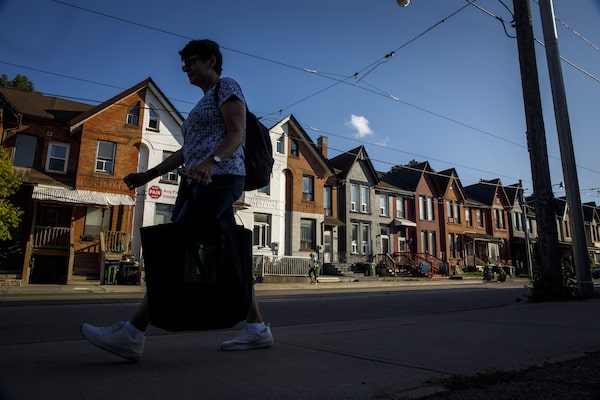
A person walks by a row of houses in Toronto. The federal government’s newly announced inflation relief for low-income Canadians through the goods and services tax rebate stacks up as better policy than some of the cash payments issued by provinces, economists say.COLE BURSTON/The Canadian Press
Alexandre Laurin is director of research at the C.D. Howe Institute. William Robson is the Institute’s CEO.
Inflation around 8 per cent is something many Canadians had never experienced until this summer. As a country, we are rediscovering how much inflation hurts. The shrinking value of our dollars is bad enough on its own, but inflation harms us in more subtle ways, including through its interactions with taxes and government benefits. Now would be a good time for some changes to lessen the pain.
Below are several examples.
When personal income tax thresholds and benefits are fixed in dollar terms, inflation pushes workers into higher tax brackets even when their real incomes do not rise. Some tax thresholds are indexed to inflation, but others are not.
Alberta, for instance, has just announced it will resume indexation this year, but inflation will keep increasing the tax burden on earners in Prince Edward Island and Nova Scotia. Ontario indexes most thresholds, but the $150,000 and $220,000 thresholds it introduced in 2014 are key omissions – inflation has eroded those thresholds to $123,000 and $181,000 in 2014 dollars, much lower than intended. All governments should index all their thresholds.
Many other tax provisions also stay the same year to year, even as prices rise. Inflation is eroding the real value of the federal government’s pension income tax credit, the First-Time Home Buyers’ Tax Credit, and the maximum amount of education and tuition credits tax filers can transfer to a spouse or parent – pain for retirees, new homeowners and the families of students. The small-supplier threshold for Ottawa’s goods and services tax has not changed in more than 30 years. Inflation has cut its real value almost in half.
Unindexed thresholds particularly affect low-income individuals. One example: Canadians may claim a refund of Employment Insurance contributions if their insurable earnings fall below $2,000. That amount has not changed since its inception in 1997. In 1997 dollars, it is now worth $1,200 – far less than intended.
Another example: the year’s basic exemption in the Canada and Quebec Pension Plans has been $3,500 since 1996. In 1996 dollars, its value is now getting down to about $2,000. More earnings – and an increasing proportion of those of low-income earners – are subject to CPP and QPP premiums every year, even if earnings are not rising in real terms.
Lack of recognition of inflation in the tax code matters in other ways. Consider the taxation of interest and dividend income. A one-year GIC currently yields about 4.4 per cent. With 8 per cent inflation, that is a negative return of about 3.5 per cent. But income taxes hit the entire nominal yield. A tax rate of, say, 40 per cent knocks the GIC’s after-tax yield down to about 2.6 per cent, which is a negative return of about 5.5 per cent after inflation.
Inflation is already turning savers into losers. Adjusting interest and dividend taxation to reflect price changes would help.
The same is true for capital gains. Most savers hold assets such as stocks, bonds and real estate for years. When inflation is high, the bulk of the nominal gain in the assets’ value – the current dollar return – is illusory. But capital gains tax hits it all. One solution would be to adjust the cost base of an asset for inflation, so only real returns would be subject to capital gains tax.
The benefit side of the tax-transfers system also needs attention. Since 2020, the Guaranteed Income Supplement for low-income seniors has exempted up to $5,000 of employment earnings, and half of the next $10,000 of earnings, from its calculation. This matters, because outside this range, the regular GIS claws back 50 cents per dollar of income, and for very low-income seniors, the GIS top-up claws back a further 25 cents.
None of the clawback thresholds are indexed to inflation, meaning that rising prices push more seniors and more of their incomes into these 50-per-cent and 75-per-cent clawback ranges.
All of these are only some of the most salient examples of the impact of inflation. Businesses also pay higher tax when rising prices, rather than real earnings, boost their taxable incomes. Inventories rise in nominal value before being sold, attracting tax, even though they will cost more to replace. Deductions for the depreciation of capital assets shrink in real terms, boosting taxable income, even though the assets, too, will cost more to replace.
These are not easy problems to fix. But when inflation is high, it gets harder to live with them.
The simplest way to reduce the pain from inflation’s interaction with taxes is to reduce inflation. But that will take time, and will create discomfort of its own. Meanwhile, governments should address the ways nonrecognition of inflation hurts earners, savers and recipients of benefits. Whatever the future rate of inflation, Canadians will enjoy the relief.